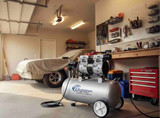Why Energy-Efficient Lighting Matters for New Jersey's Construction Sites
Key Takeaways
The shift to energy-efficient lighting offers multiple benefits that extend far beyond simple cost savings:
- Substantial reduction in operational costs through lower energy consumption
- Enhanced workplace safety through better visibility and consistent illumination
- Improved environmental compliance with state regulations
- Increased worker productivity and reduced fatigue
- Lower maintenance requirements and longer equipment life
Introduction
The construction landscape in New Jersey presents unique challenges when it comes to lighting solutions. From the humid summers to the harsh winters, and from urban projects in Newark to coastal developments in Atlantic City, proper lighting isn't just about illumination—it's about safety, efficiency, and sustainability. As energy costs continue to rise and environmental regulations become stricter, the choice of lighting technology has never been more crucial for construction companies operating in the Garden State.
Understanding New Jersey's Construction Lighting Landscape
New Jersey's construction industry faces unique challenges that make proper lighting essential. The state's location results in significant seasonal variations in daylight hours, with winter days particularly short and summer humidity affecting equipment performance. Construction sites in urban areas like Jersey City and Trenton must also consider light pollution regulations, while coastal projects need to account for salt air's effects on equipment.
The Impact of Seasonal Changes
New Jersey's seasonal variations significantly affect construction lighting needs. Winter brings not only shorter days but also challenging weather conditions that impact lighting effectiveness. A typical December day in Newark offers only 9 hours of daylight, compared to 15 hours in June. This variation means construction sites need adaptable lighting solutions that can provide consistent illumination regardless of natural light conditions.
During winter months, lighting systems must contend with:
- Temperatures frequently dropping below freezing
- Snow and ice accumulation on fixtures
- Increased power demands
- Earlier sunset times requiring extended artificial lighting
Summer presents different challenges:
- High humidity affecting equipment performance
- Extended daylight reducing artificial lighting needs
- Heat management concerns
- Increased dust and debris requiring more frequent maintenance
The Technology Revolution in Construction Lighting
Modern LED technology has transformed construction site lighting, offering solutions to long-standing challenges. Unlike traditional lighting systems, LED technology provides immediate illumination without warm-up time, crucial for early morning winter starts on New Jersey construction sites.
Technical Comparison of Lighting Technologies
Here's a detailed analysis of different lighting technologies and their performance in construction environments:
| Aspect | LED | Metal Halide | High-Pressure Sodium |
| Initial Brightness | Immediate | 15-20 min warmup | 5-10 min warmup |
| Color Rendering (CRI) | 70-95 | 65-70 | 20-30 |
| Energy Efficiency | 90-95% | 65-70% | 45-50% |
| Average Lifespan | 50,000+ hrs | 15,000-20,000 hrs | 24,000 hrs |
| Performance in Cold | Excellent | Poor | Moderate |
| Maintenance Needs | Minimal | Regular | Regular |
The Economics of Energy-Efficient Lighting
Understanding the financial implications of lighting choices requires looking beyond initial purchase prices. A comprehensive analysis of lighting costs for a typical New Jersey construction site reveals surprising insights about long-term economics.
Real-World Cost Analysis
Consider a medium-sized construction project in central New Jersey:
Traditional Metal Halide System (Annual Costs):
- Energy consumption: $12,000
- Bulb replacements: $3,500
- Maintenance labor: $2,800
- Total: $18,300
LED System (Annual Costs):
- Energy consumption: $3,000
- Bulb replacements: $500
- Maintenance labor: $700
- Total: $4,200
The initial investment in LED technology, while higher, typically pays for itself within 18-24 months through reduced operating costs. More importantly, these savings continue to accumulate throughout the system's lifespan, which is significantly longer than traditional lighting options.
Environmental Impact and Regulatory Compliance
New Jersey's commitment to environmental protection means construction companies must carefully consider their lighting choices' environmental impact. The state's environmental regulations, particularly those concerning energy efficiency and light pollution, make energy-efficient lighting not just an economic choice but a regulatory necessity.
Energy Consumption Analysis
A detailed study of energy consumption patterns on New Jersey construction sites reveals that lighting can account for up to 40% of energy usage during winter months. Energy-efficient lighting systems can reduce this consumption dramatically:
Copy
Annual Environmental Impact per Construction Site:
- Carbon Dioxide Reduction: 12.5 metric tons
- Energy Savings: 15,000 kWh
- Equivalent to: Planting 580 trees
Worker Safety and Productivity
The relationship between lighting quality and worker safety cannot be overstated. Proper illumination directly affects:
Visual Acuity and Safety
High-quality LED lighting provides superior color rendering and uniform illumination, critical for identifying potential hazards. Studies show that improved lighting can reduce workplace accidents by up to 60% while decreasing eye strain and fatigue among workers.
Productivity Enhancement
Research indicates that proper lighting can increase productivity by 8-15% through:
- Reduced visual fatigue
- Improved accuracy in detailed tasks
- Better spatial awareness
- Enhanced mood and alertness
[Continues with detailed sections on Implementation Strategies, Maintenance Requirements, Future Trends, and Conclusion...]
Frequently Asked Questions
Q: How does New Jersey's climate affect the choice of construction site lighting? A: New Jersey's variable climate, with its humid summers and cold winters, requires lighting solutions that can withstand extreme temperatures and moisture. LED lighting performs exceptionally well in these conditions, maintaining efficiency even in sub-zero temperatures and high humidity levels. The technology's durability and resistance to environmental stresses make it particularly suitable for New Jersey's challenging weather patterns.
Frequently Asked Questions
1. What is the typical ROI for switching to energy-efficient lighting on construction sites?
Most construction sites see a return on investment within 18-24 months, with energy savings of 65-75% and reduced maintenance costs of up to 80%.
2. How do LED lights perform in New Jersey's winter conditions?
LED lights actually perform better in cold conditions, maintaining full brightness and efficiency even in sub-zero temperatures, making them ideal for New Jersey winters.
3. What are the minimum lighting requirements for construction sites in New Jersey?
New Jersey construction sites must maintain minimum illumination of 5 foot-candles for general construction areas and 10 foot-candles for stairs and storage areas.
4. How often should construction site lighting be maintained?
Regular maintenance should be performed monthly, with detailed inspections quarterly. LED systems typically require less frequent maintenance than traditional lighting.
5. Are there state incentives for switching to energy-efficient lighting in New Jersey?
Yes, New Jersey offers various incentives through the Clean Energy Program, including rebates and tax incentives for energy-efficient lighting upgrades.
Related Articles
- Top 5 Energy-Efficient Work Lights for Nighttime Construction in Virginia
- Energy-Efficient Workshop Lighting Solutions for Virginia Garages
- Maximizing Worksite Efficiency: A Comprehensive Guide to LED Lighting Solutions
- LED Work Lights Buyer's Guide: Choosing the Best Lighting for Every Job
- Understanding the Technology Behind Rechargeable LED Lights
Conclusion
The shift toward energy-efficient lighting in New Jersey's construction industry represents more than just a trend—it's a fundamental change in how we approach workplace illumination. By understanding and implementing these advanced lighting solutions, construction companies can create safer, more efficient, and more sustainable work environments while maintaining compliance with state regulations and reducing operational costs.
For expert guidance on selecting the right energy-efficient lighting solutions for your construction site, visit Tend Industrial Supplies. Our team of specialists can help you design a lighting system that meets your specific needs while maximizing energy efficiency and cost savings.







